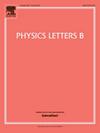Angular analysis of the B0 → K⁎(892)0μ+μ− decay in proton-proton collisions at s=13TeV
IF 4.3
2区 物理与天体物理
Q1 ASTRONOMY & ASTROPHYSICS
引用次数: 0
Abstract
A full set of optimized observables is measured in an angular analysis of the decay using a sample of proton-proton collisions at , collected with the CMS detector at the LHC, corresponding to an integrated luminosity of 140 . The analysis is performed in six bins of the squared invariant mass of the dimuon system, , over the range . The results are among the most precise experimental measurements of the angular observables for this decay and are compared to a variety of predictions based on the standard model. Some of these predictions exhibit tension with the measurements.
求助全文
约1分钟内获得全文
求助全文
来源期刊

Physics Letters B
物理-物理:综合
CiteScore
9.10
自引率
6.80%
发文量
647
审稿时长
3 months
期刊介绍:
Physics Letters B ensures the rapid publication of important new results in particle physics, nuclear physics and cosmology. Specialized editors are responsible for contributions in experimental nuclear physics, theoretical nuclear physics, experimental high-energy physics, theoretical high-energy physics, and astrophysics.
 求助内容:
求助内容: 应助结果提醒方式:
应助结果提醒方式:


